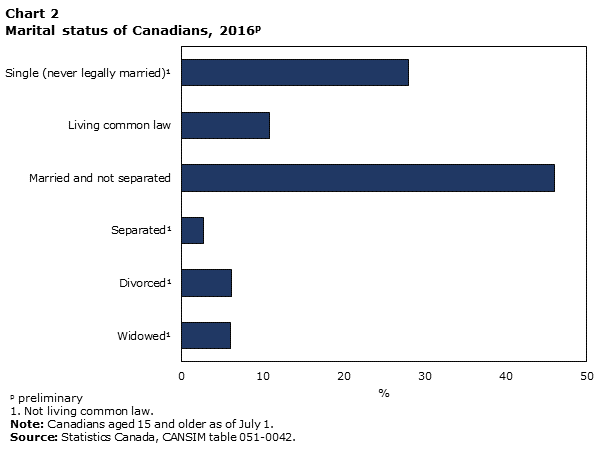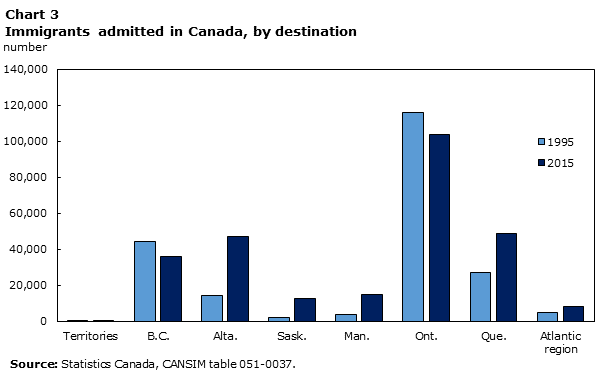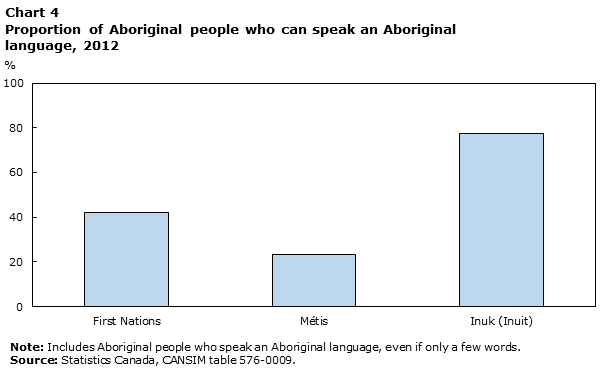Canada at a Glance 2017
Population
Archived Content
Information identified as archived is provided for reference, research or recordkeeping purposes. It is not subject to the Government of Canada Web Standards and has not been altered or updated since it was archived. Please "contact us" to request a format other than those available.
| 2006 | 2011 | 2016 | 2006 to 2016 | |
|---|---|---|---|---|
| number | % change | |||
| Canada | 31,612,897 | 33,476,688 | 35,151,728 | 11.2 |
| Newfoundland and Labrador | 505,469 | 514,536 | 519,716 | 2.8 |
| Prince Edward Island | 135,851 | 140,204 | 142,907 | 5.2 |
| Nova Scotia | 913,462 | 921,727 | 923,598 | 1.1 |
| New Brunswick | 729,997 | 751,171 | 747,101 | 2.3 |
| Quebec | 7,546,131 | 7,903,001 | 8,164,361 | 8.2 |
| Ontario | 12,160,282 | 12,851,821 | 13,448,494 | 10.6 |
| Manitoba | 1,148,401 | 1,208,268 | 1,278,365 | 11.3 |
| Saskatchewan | 968,157 | 1,033,381 | 1,098,352 | 13.4 |
| Alberta | 3,290,350 | 3,645,257 | 4,067,175 | 23.6 |
| British Columbia | 4,113,487 | 4,400,057 | 4,648,055 | 13.0 |
| Yukon | 30,372 | 33,897 | 35,874 | 18.1 |
| Northwest Territories | 41,464 | 41,462 | 41,786 | 0.8 |
| Nunavut | 29,474 | 31,906 | 35,944 | 22.0 |
| Source: Statistics Canada, 2016, 2011 and 2006 Censuses of Population. | ||||
| 1995/1996 | 2005/2006 | 2015/2016Note p: preliminary | |
|---|---|---|---|
| number | |||
| Births | 372,453 | 346,082 | 392,902 |
| Deaths | 209,766 | 225,489 | 269,012 |
| Immigrants | 217,478 | 254,374 | 320,932 |
| Emigrants | 48,396 | 57,851 | 64,305 |
| Returning emigrants | 19,035 | 34,855 | 37,564 |
| Net temporary emigrants | 19,745 | 27,652 | 18,418 |
| Net non-permanent residents | -826 | 15,852 | 38,152 |
|
p preliminary Note: All figures are for the one-year period ending June 30. Source: Statistics Canada, CANSIM table 051-0004. |
|||

Data Table for Chart 1
| Total growth | Natural increase | Net international migration | |
|---|---|---|---|
| 1985/1986 | 278,327 | 192,028 | 86,299 |
| 1986/1987 | 348,988 | 190,423 | 158,565 |
| 1987/1988 | 347,819 | 180,116 | 167,703 |
| 1988/1989 | 487,699 | 195,627 | 292,072 |
| 1989/1990 | 417,024 | 210,672 | 206,352 |
| 1990/1991 | 350,535 | 210,490 | 140,045 |
| 1991/1992 | 358,027 | 206,140 | 151,887 |
| 1992/1993 | 337,620 | 190,373 | 147,247 |
| 1993/1994 | 340,015 | 179,695 | 160,320 |
| 1994/1995 | 325,769 | 172,609 | 153,160 |
| 1995/1996 | 330,233 | 162,687 | 167,546 |
| 1996/1997 | 305,708 | 140,092 | 165,616 |
| 1997/1998 | 259,203 | 127,435 | 131,768 |
| 1998/1999 | 256,090 | 120,663 | 135,427 |
| 1999/2000 | 294,452 | 119,683 | 174,769 |
| 2000/2001 | 344,693 | 107,993 | 236,700 |
| 2001/2002 | 346,639 | 107,661 | 238,978 |
| 2002/2003 | 292,028 | 106,618 | 185,410 |
| 2003/2004 | 305,214 | 108,933 | 196,281 |
| 2004/2005 | 313,174 | 109,364 | 203,810 |
| 2005/2006 | 340,171 | 120,593 | 219,578 |
| 2006/2007 | 351,741 | 127,091 | 224,650 |
| 2007/2008 | 392,257 | 137,170 | 255,087 |
| 2008/2009 | 417,114 | 141,582 | 275,532 |
| 2009/2010 | 411,019 | 142,235 | 268,784 |
| 2010/2011 | 366,935 | 131,983 | 234,952 |
| 2011/2012 | 407,765 | 137,340 | 270,425 |
| 2012/2013 | 404,906 | 133,712 | 271,194 |
| 2013/2014 | 389,113 | 132,265 | 256,848 |
| 2014/2015 | 304,046 | 123,750 | 180,296 |
| 2015/2016 | 437,815 | 123,890 | 313,925 |
| Source: Statistics Canada, CANSIM table 051-0004. | |||

Data Table for Chart 2
| 2016 | |
|---|---|
| % | |
| WidowedChart 2 Note 1 | 6.0 |
| DivorcedChart 2 Note 1 | 6.2 |
| SeparatedChart 2 Note 1 | 2.7 |
| Married and not separated | 46.1 |
| Living common law | 10.9 |
| Single (never legally married)Chart 2 Note 1 | 28.0 |
p preliminary
Source: Statistics Canada, CANSIM table 051-0042. |
|
| 1996 | 2006 | 2016 | |
|---|---|---|---|
| % of the population | |||
| 0 to 17 years | 24.3 | 21.5 | 19.3 |
| 18 to 24 years | 9.4 | 9.6 | 9.2 |
| 25 to 44 years | 32.8 | 28.8 | 27.1 |
| 45 to 64 years | 21.3 | 26.9 | 27.8 |
| 65 years and older | 12.1 | 13.2 | 16.5 |
| 90 years and older | 0.4 | 0.5 | 0.8 |
| median age | |||
| Total population | 35.2 | 38.9 | 40.6 |
|
Note: Age composition statistics are based on population estimates, which should not be confused with the 2016 Census population counts that were released on February 8, 2017. Source: Statistics Canada, CANSIM table 051-0001. |
|||

Data Table for Chart 3
| 1995 | 2015 | |
|---|---|---|
| Territories | 212 | 515 |
| B.C. | 44,603 | 35,746 |
| Alta. | 14,360 | 47,217 |
| Sask. | 1,949 | 12,521 |
| Man. | 3,605 | 14,906 |
| Ont. | 115,944 | 103,655 |
| Que. | 27,228 | 48,982 |
| Atlantic region | 4974 | 8295 |
| Source: Statistics Canada, CANSIM table 051-0037. | ||
| 2006 | 2016 | 2006 to 2016 | |
|---|---|---|---|
| number | % change | ||
| Total population | 31,612,897 | 35,151,728 | 11.2 |
| St. John's | 181,113 | 205,955 | 13.7 |
| Halifax | 372,858 | 403,390 | 8.2 |
| Moncton | 126,424 | 144,810 | 14.5 |
| Saint John | 122,389 | 126,202 | 3.1 |
| Saguenay | 151,643 | 160,980 | 6.2 |
| Québec | 715,515 | 798,162 | 11.6 |
| Sherbrooke | 186,952 | 212,105 | 13.5 |
| Trois-Rivières | 141,529 | 156,042 | 10.3 |
| Montréal | 3,635,571 | 4,098,927 | 12.7 |
| Ottawa–Gatineau | 1,130,761 | 1,323,783 | 17.1 |
| Kingston | 152,358 | 161,175 | 5.8 |
| Belleville | 91,518 | 103,472 | 13.1 |
| Peterborough | 116,570 | 121,721 | 4.4 |
| Oshawa | 330,594 | 379,848 | 14.9 |
| Toronto | 5,113,149 | 5,928,040 | 15.9 |
| Hamilton | 692,911 | 747,545 | 7.9 |
| St. Catharines–Niagara | 390,317 | 406,074 | 4.0 |
| Kitchener–Cambridge–Waterloo | 451,235 | 523,894 | 16.1 |
| Brantford | 124,607 | 134,203 | 7.7 |
| Guelph | 127,009 | 151,984 | 19.7 |
| London | 457,720 | 494,069 | 7.9 |
| Windsor | 323,342 | 329,144 | 1.8 |
| Barrie | 177,061 | 197,059 | 11.3 |
| Greater Sudbury | 158,258 | 164,689 | 4.1 |
| Thunder Bay | 122,907 | 121,621 | -1.0 |
| Winnipeg | 694,668 | 778,489 | 12.1 |
| Regina | 194,971 | 236,481 | 21.3 |
| Saskatoon | 233,923 | 295,095 | 26.2 |
| Lethbridge | 95,196 | 117,394 | 23.3 |
| Calgary | 1,079,310 | 1,392,609 | 29.0 |
| Edmonton | 1,034,945 | 1,321,426 | 27.7 |
| Kelowna | 162,276 | 194,882 | 20.1 |
| Abbotsford–Mission | 159,020 | 180,518 | 13.5 |
| Vancouver | 2,116,581 | 2,463,431 | 16.4 |
| Victoria | 330,088 | 367,770 | 11.4 |
| Sources: Statistics Canada, 2006 and 2016 Censuses of Population. | |||

Data Table for Chart 4
| % | |
|---|---|
| First Nations | 42.1 |
| Métis | 23.3 |
| Inuk (Inuit) | 77.5 |
|
Note: Includes Aboriginal people who speak an Aboriginal language, even if only a few words. Source: Statistics Canada, CANSIM table 576-0009. |
|
- Date modified:
